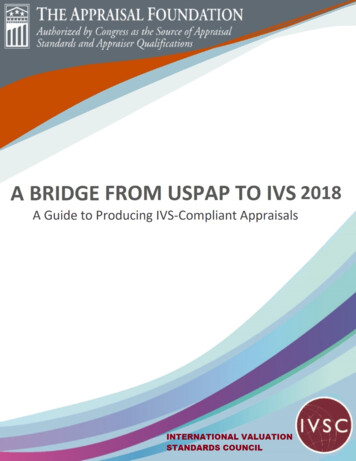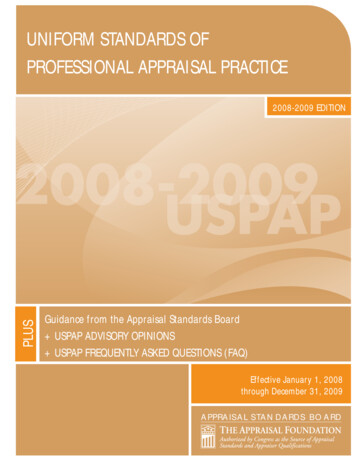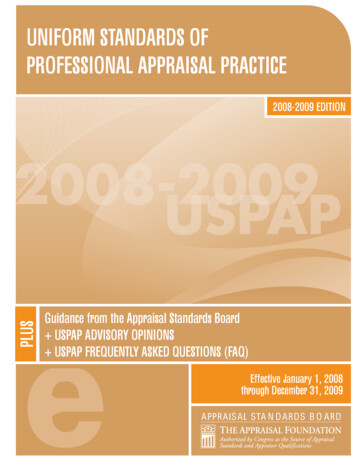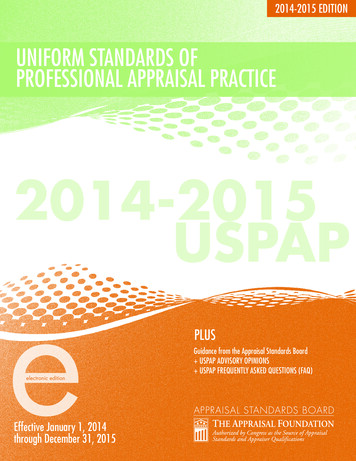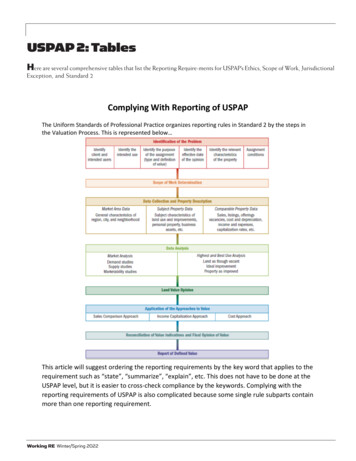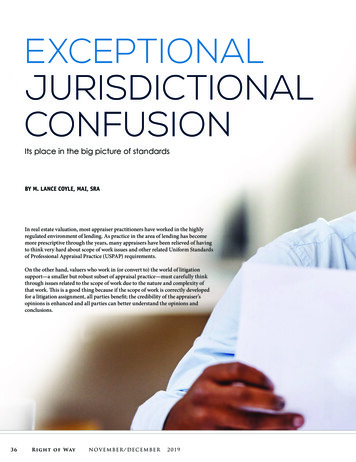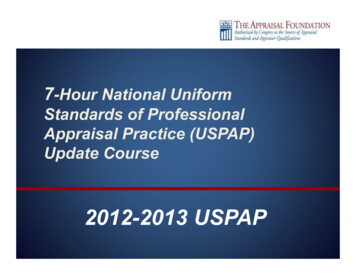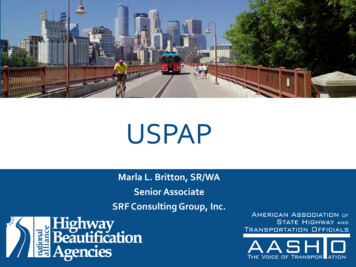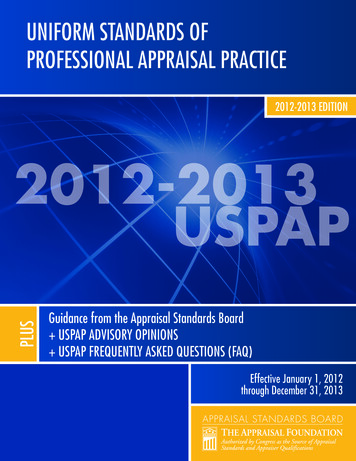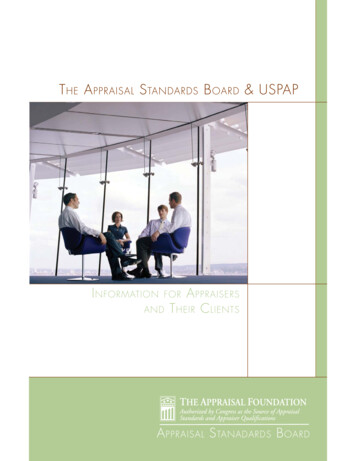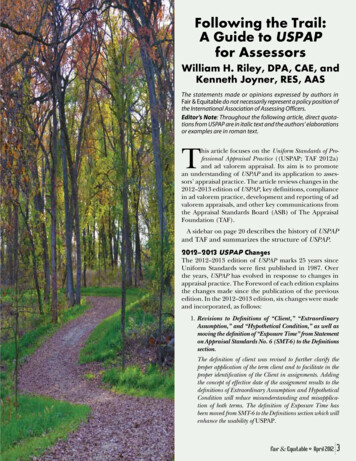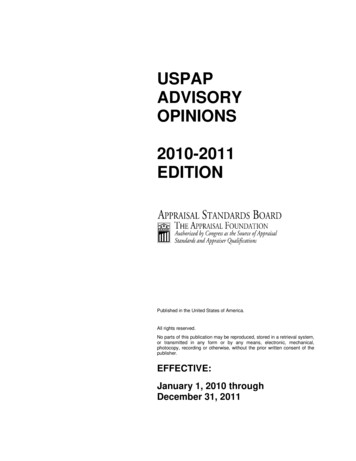
Transcription
USPAPADVISORYOPINIONS2010-2011EDITIONPublished in the United States of America.All rights reserved.No parts of this publication may be reproduced, stored in a retrieval system,or transmitted in any form or by any means, electronic, mechanical,photocopy, recording or otherwise, without the prior written consent of thepublisher.EFFECTIVE:January 1, 2010 throughDecember 31, 2011
FOREWORDThe A ppraisal S tandards B oard ( ASB) of The A ppraisal F oundation de velops, i nterprets, a nd a mends t heUniform Standards of Professional Appraisal Practice (USPAP) on behalf of appraisers and users of appraisalservices. The 2010-2011 Edition of USPAP (2010-2011 USPAP) is effective January 1, 2010 throughDecember 31, 2011. It i s i mportant t hat individuals understand a nd a dhere t o c hanges in e ach e dition o fUSPAP. State and federal authorities enforce the content of the current or applicable edition of USPAP.Advisory Opinions are a form of guidance issued by the ASB to illustrate the applicability of USPAP in specificsituations a nd t o of fer a dvice f rom t he ASB f or t he r esolution of a ppraisal i ssues a nd pr oblems. AdvisoryOpinions d o n ot e stablish new s tandards o r in terpret e xisting standards. A dvisory O pinions are n ot p art o fUSPAP and can be approved by the ASB without public exposure and comment.Advisory O pinions a re ba sed on pr esumed c onditions without i nvestigation or v erification o f a ctualcircumstances. Guidance provided in the Advisory Opinions does not represent the only possible solution to theissues discussed and the advice provided may not be applied equally to seemingly similar situations.The USPAP Advisory Opinions are a reference for appraisers, enforcement officials, users of appraisal services,and the public. The use of this edition of the USPAP Advisory Opinions is intended to be in conjunction withthe 2010-2011 Edition of USPAP.Contacting the Appraisal Standards BoardThe ASB i nvites q uestions a bout U SPAP, c ommentary on USPAP and proposed changes to USPAP from allinterested parties, including appraisers, state enforcement agencies, users of appraisal services, and the public.If you have any comments, questions, or suggestions regarding USPAP, please contact the ASB.Appraisal Standards BoardThe Appraisal Foundation1155 15th Street, NW, Suite 1111Washington, DC 20005Phone: 202-347-7722Fax: 202-347-7727E-Mail: n.org The Appraisal FoundationA-i
TABLE OF CONTENTSUSPAP ADVISORY OPINIONSEach Advisory Opinion is labeled as to its applicability to the various appraisal disciplines. The abbreviationsare: Real Property – RPPersonal Property – PPIntangible Property – IP (includes business interests)All disciplines – ALLAO-1 Sales History (RP) . A-1AO-2 Inspection of Subject Property (RP, PP). A-4AO-3 Update of a Prior Appraisal (ALL) . A-7AO-4 Standards Rule 1-5(b) (RP) . A-10AO-5 Assistance in the Preparation of an Appraisal - Retired . A-11AO-6 The Appraisal Review Function - Retired . A-12AO-7 Marketing Time Opinions (RP, PP) . A-13AO-8 Market Value vs. Fair Value in Real Property Appraisals - Retired . A-15AO-9 The Appraisal of Real Property That May Be Impacted by EnvironmentalContamination (RP) . A-16AO-10 The Appraiser-Client Relationship - Retired . A-20AO-11 Content of the Appraisal Report Options of Standards Rules 2-2 and 8-2 (RP, PP) . A-21AO-12 Use of the Appraisal Report Options of Standards Rules 2-2 and 8-2 (RP, PP). A-26AO-13 Performing Evaluations of Real Property Collateral to Conform with USPAP (RP) . A-28AO-14 Appraisals for Subsidized Housing (RP) . A-32AO-15 Using the DEPARTURE RULE in Developing a Limited Appraisal - Retired . A-35AO-16 Fair Housing Laws and Appraisal Report Content (RP) . A-36AO-17 Appraisals of Real Property with Proposed Improvements (RP) . A-39AO-18 Use of an Automated Valuation Model (AVM) (ALL) . A-44AO-19 Unacceptable Assignment Conditions in Real Property Appraisal Assignments (RP) . A-51AO-20 An Appraisal Review Assignment That Includes the Reviewer’s Own Opinionof Value (ALL) . A-56AO-21 USPAP Compliance (ALL) . A-63AO-22 Scope of Work in Market Value Appraisal Assignments, Real Property (RP) . A-73AO-23 Identifying the Relevant Characteristics of the Subject Property of a Real PropertyAppraisal Assignment (RP) . A-80AO-24 Normal Course of Business (RP, PP) . A-84AO-25 Clarification of the Client in a Federally Related Transaction (RP) . A-87AO-26 Readdressing (Transferring) a Report to Another Party (ALL) . A-89AO-27 Appraising the Same Property for a New Client (ALL) . A-91AO-28 Scope of Work Decision, Performance, and Disclosure (ALL) . A-95AO-29 An Acceptable Scope of Work (ALL) . A-99AO-30 Appraisals for Use by a Federally Regulated Financial Institution (RP) . A-102AO-31 Assignments Involving More Than One Appraiser (ALL). A-107AO-32 Ad Valorem Property Tax Appraisal and Mass Appraisal Assignments (RP, PP) . A-111A-ii The Appraisal Foundation
ADVISORY OPINION 11ADVISORY OPINION 1 (AO-1)234This communication by the Appraisal Standards Board (ASB) does not establish new standards or interpretexisting standards. Advisory Opinions are issued to illustrate the applicability of appraisal standards in specificsituations and to offer advice from the ASB for the resolution of appraisal issues and problems.5SUBJECT: Sales History6APPLICATION: Real Property7THE ISSUE:891011121314The Uniform Standards of Professional Appraisal Practice (USPAP) contain s ales history requirements thatobligate appraisers of real property to analyze and report pending and recent agreements, options, listings, andsales involving the property being appraised. Because of differences in federal la w and regulations, state lawsand operating p ractices r elating to t he disclosure a nd confidentiality of real property s ales data, t he ways i nwhich ap praisers co mply with t he sales h istory r equirements vary acco rding t o t he j urisdiction and t heavailability o f i nformation. This la ck o f c onsistency h as r aised q uestions r egarding th e a pplicability a ndrelevance of the sales history requirements.1516How can the appraiser best comply with the sales history provisions of the applicable appraisal standards in theface of obstacles that are beyond the control of the appraiser?17ADVICE FROM THE ASB ON THE ISSUE:18Relevant USPAP & Advisory References19 Advisory Opinion 24 which addresses the “normal course of business.”20Analysis and Reporting Requirements2122This Advisory Opinion offers advice and guidance for compliance with the requirements to analyze and reportsales history and related information in the appraisal of real property.2324252627282930USPAP Standards Rules 1-5(a) and (b) require an appraiser, when the value opinion to be developed is marketvalue, and if such information is available to the appraiser in the normal course of business, to analyze (1) allagreements of sale, options, o r listings of the subject property current as o f the effective date of the appraisaland ( 2) al l s ales o f t he s ubject p roperty t hat o ccurred within three ( 3) years p rior t o t he ef fective d ate o f theappraisal. U SPAP S tandards Rules 2 -2(a)(viii), ( b)(viii), a nd ( c)(viii) c all f or t he written a ppraisal r eport tocontain sufficient i nformation to in dicate c ompliance with th e s ales history r equirement. S tandards R ules 22(a)(viii), ( b)(viii), a nd ( c)(viii) f urther r equire th at, i f s ales h istory in formation is unobtainable, th e writtenappraisal report must include a commentary on the efforts taken by the appraiser to obtain the information.313233Laws, r egulations a nd guidelines i ssued b y government a gencies, or g overnment s ponsored e nterprises, alsocontain r equirements t hat r equire t he ap praiser t o an alyze an d r eport s ales history i nformation, a nd t heserequirements vary according to jurisdiction.343536373839The requirement for the appraiser to analyze and report sales history and related information is fundamental tothe appraisal process. Just as the appraiser must analyze pending and recent sales of comparable properties, theappraiser must take into account all pending and recent sales of the subject property itself. This is not to say thatthe agreed price in a pending or r ecent sale o f the subject property is necessarily representative of value asdefined i n t he r eport, b ut t he ap praiser’s failure t o a nalyze an d r eport t hese f acts may e xclude importantinformation from the sales comparison approach. Information pertaining to the current market status and theUSPAP Advisory Opinions 2010-2011 Edition The Appraisal FoundationA-1
ADVISORY OPINION 14041sales history of the subject property may also be useful information for the determination of highest and best useor the analysis of market trends.42Sample Sales Histories4344The f ollowing sample s ales histories ar e o ffered as ex amples o f i nformation t hat might b e i ncluded i n a nappraisal report in compliance with the applicable standards.454647For a property that is not under agreement or option, that is not offered for sale on the open market and that hasnot c hanged hands within t he p ast t hree years, t he sales history might b e s hown i n t he a ppraisal report asfollows:48495051Research of the applicable public records, private data services and an interview of the current owner,revealed that the subject property is not under current agreement or option and is not offered for saleon t he o pen market. Additionally, acco rding t o t hese s ources, t he s ubject p roperty has not b eentransferred during the past three years.5253For a property that is offered for sale on the open market and that was acquired by the current owner during thepast three years, the sales history to be included in the appraisal report might appear as follows.5455The subject property is currently offered for sale at a listing price of XXX,XXX. A copy of the listingagreement with Mary Smith, real estate broker, is included in the addendum to this report.5657585960The subject property was sold by John Jones to the current owner on June 1, 20XX, for a reportedprice of XXX,XXX. The parties to the transaction have affirmed that the seller received all cash andthat the reported price was unaffected by special or creative financing or sales concessions granted byanyone associated with the sale. This sale is analyzed in the Sales Comparison Approach section of theappraisal report.6162According to the public records, there have been no other transfers of the subject property within thepast three years.63Sample Comments646566The following sample co mments are o ffered as examples o f co mments that might be included in an appraisalreport in c ases where p ertinent in formation is not a vailable to the a ppraiser in the normal c ourse o f b usiness.The comments are fictitious and are offered only for purposes of illustration.67686970In cas es where t he p roperty being ap praised i s k nown t o b e t he s ubject o f a p ending t ransaction, b ut t heappraiser is not privy to the terms of the pending transaction and the parties to the transaction have declined todisclose t he t erms of the t ransaction to t he ap praiser, t he sales history to be included i n t he ap praisal reportmight include a comment such as the one shown below.71727374The property being appraised is known to be the subject of a pending purchase and sale agreement, butthe appraiser was unable to obtain the terms o f the agreement. The current o wner confirmed that theproperty is under agreement but declined to disclose the terms of the agreement or to discuss the natureof the agreement.757677In jurisdictions where reliable price information cannot be found in the public records and where the appraiseris unable to obtain complete information in the normal course of business, it would be appropriate to include inthe appraisal report a comment similar to the one shown below.A-2USPAP Advisory Opinions 2010-2011 Edition The Appraisal Foundation
ADVISORY OPINION 1787980The subject property was sold by John Jones to the current owner on June 1, 20XX, for an unknownprice. The appraiser attempted to obtain the purchase price and other terms of the transaction withoutsuccess. The parties to the transaction declined to discuss the terms or conditions of the sale.8182According to the public records, there have been no other transfers of the subject property within thepast three years.USPAP Advisory Opinions 2010-2011 Edition The Appraisal FoundationA-3
ADVISORY OPINION 21ADVISORY OPINION 2 (AO-2)234This communication by the Appraisal Standards Board (ASB) does not establish new standards or interpretexisting standards. Advisory Opinions are issued to illustrate the applicability of appraisal standards in specificsituations and to offer advice from the ASB for the resolution of appraisal issues and problems.5SUBJECT: Inspection of Subject Property6APPLICATION: Real Property, Personal Property7THE ISSUE:89For r eal property an d p ersonal p roperty ap praisal as signments, U SPAP r equires t he r eport t o co ntain acertification indicating whether or not the subject property was personally inspected by the appraiser(s).10 What is the purpose of inspecting the subject property?11 Does USPAP mandate a minimum level of property inspection?12 What are the disclosure obligations relating to inspection?13ADVICE FROM THE ASB ON THE ISSUE14Purpose of an Inspection1516The primary reason for inspection of a property is to gather information about the characteristics of the propertythat are relevant to its value. 11718While there are other ways to gather such information, in many cases the personal observations of the appraiserare the primary source of information regarding the subject property.19Minimum Level of Inspection20212223An i nspection i s not required by U SPAP, bu t on e i s of ten c onducted. While a n inspection i s n ot r equired,appraisal reports for real and personal property must contain a signed certification which clearly states whetherthe appraiser h as or h as n ot p ersonally i nspected the subject p roperty. T his is f urther discussed u nder theDisclosure Requirements section which follows.24252627The ex tent o f t he i nspection process i s an a spect o f t he scope o f work, and may vary based o n as signmentconditions and the intended use of the assignment results. 2 It is the appraiser’s responsibility to determine theappropriate scope of work, including the degree of inspection necessary to produce credible assignment resultsgiven the intended use.28293031Every a ssignment is s ubject to c onditions t hat limit, i n o ne way o r a nother, the i nspection o f t he subjectproperty. R egardless of t he detail on e e mploys, i t i s a lways pos sible t o pe rform a n i nspection t hat i s morethorough. The appraiser’s inspection commonly is limited to those things readily observable without the use ofspecial testing or equipment.3233An a ppraiser m ay us e a ny c ombination of pr operty i nspection, pl ans a nd s pecifications, a sset r ecords,photographs, property sketches, recorded media, etc., to gather information about the relevant characteristics of12See Advisory Opinion 23, Identifying the Relevant Characteristics of the Subject Property of a Real Property Appraisal Assignment.See Advisory Opinion 28, Scope of Work Decision, Performance, and Disclosure.A-4USPAP Advisory Opinions 2010-2011 Edition The Appraisal Foundation
ADVISORY OPINION 2343536the s ubject p roperty. 3 For s ome a ssignments, i t may be n ecessary to r ely on r eports pr epared by ot herprofessionals. In such cases the appraiser must co mply with USPAP requirements related to reliance on workdone by others.3738394041There ar e m any ci rcumstances t hat i nfluence t he e xtent o f t he ap praiser’s p roperty i nspection. I n s omeassignments, the cl ient may request t hat t he appraiser perform an e xterior-only i nspection from the street o rperform no inspection of the subject property (i.e., a “desktop appraisal”). There are situations where inspectionof the subject property is not possible; for example, if the improvements have been destroyed, removed, or notyet built. In other cases the appraiser is denied access to the property.4243444546The appraiser must ensure that the degree of inspection is adequate to develop a credible appraisal. An appraisercannot d evelop a cr edible ap praisal i f ad equate i nformation ab out t he r elevant ch aracteristics o f t he s ubjectproperty is not available. W hen ad equate i nformation ab out r elevant characteristics i s not available t hrough apersonal inspection or from sources the appraiser believes are reliable, an appraiser must withdraw from theassignment unless the appraiser can: 47484950 modify the assignment conditions to expand the scope of work to include gathering the necessaryinformation; oruse an extraordinary assumption about such information, if credible assignment results can still bedeveloped.5152535455An i nspection co nducted b y an ap praiser i s us ually not t he e quivalent o f a n i nspection b y a n i nspectionprofessional (e.g., a structural engineer, a licensed home inspector, a Renaissance art expert). An appraiser’sobservations must, at the minimum, be thorough enough to properly develop the appraisal and adequately reportthe relevant characteristics. R egardless of h ow the in formation is g athered, it m ust b e sufficient f or thedevelopment of relevant analyses, such as highest and best use, the application of the approaches, etc.56Disclosure Requirements57585960Appraisal r eports f or r eal a nd p ersonal p roperty must co ntain a s igned cer tification i ndicating whether t heappraiser h as o r h as not p ersonally i nspected t he s ubject p roperty. All ap praisal r eports must al so co ntainsufficient i nformation to enable t he intended u sers t o understand t he e xtent o f t he i nspection t hat wasperformed.6162Because of the infinite variability of inspections, it is important that the appraisal report clearly communicatesthe degree of the inspection in order for the report to be meaningful. 463Illustrations64651.I have b een as ked to ap praise a s ingle-family home b ased o n an exterior-only i nspection from t he street.What are my development and reporting obligations?If an ap praiser’s o bservations ar e l imited t o a n e xterior-only in spection f rom th e s treet, then theappraiser m ust gather information o n r elevant c haracteristics f rom o ther d ata sources an d/or u seextraordinary a ssumptions. 5 The d ata s ources u sed ar e o ften the same s ources u sed t o g atherinformation on comparable sales. For example, the size of the property might be obtained from publicrecords, and other information might be obtained from interior photographs included in a listing of theproperty for sale, or information from the appraiser’s own files.666768697071345See Comment to Standards Rules 1-2(e) and 7-2(e).See Standards Rules 2-2(a)(vii), 2-2(b)(vii), 2-2(c)(vii), 7-2(a)(vii), 7-2(b)(vii) and 7-2(c)(vii).See Standards Rules 2-2(a)(x), 2-2(b)(x), 2-2(c)(x), 7-2(a)(x), 7-2(b)(x) and 7-2(c)(x).USPAP Advisory Opinions 2010-2011 Edition The Appraisal FoundationA-5
ADVISORY OPINION 2The report must disclose the extent of the property inspection in a manner that is clear to the intendedusers. For example, in this case it would probably be insufficient to merely state that the property wasinspected. The r eport must make cl ear t hat t he ap praisal was b ased o n an “exterior o nly” i nspectionfrom t he s treet a nd s tate th e s ources u sed to id entify the r elevant c haracteristics o ther t han t hoseobserved during the inspection.72737475767778792.Yes, if the data provided contains sufficient information about the subject’s relevant characteristics, onecould de velop a n a ppraisal ba sed on t he information d escribed in th e ill ustration. Without d irectlyinspecting the watch, however, the information provided is “assumed” to be accurate. Because some ofthese assumptions will have a significant effect on the assignment results, the assignment will involvethe u se o f ex traordinary as sumptions an d r equire p roper d isclosure. The s cope o f work i n t heassignment, including the degree of the inspection, must provide results that are credible in the contextof the intended use. 680818283848586878889909192A dealer has asked me to appraise a R olex watch. I will not be provided access to the piece. H owever, Ihave been given the serial number, a copy of an authenticity certificate and several recent photographs ofthe watch. Can I develop an appraisal based solely on this information?3.I have been contacted by a p roperty owner who is being transferred by his company to another city. Theowner indicated that while he might want a “detailed appraisal” later, right now he only needs a rough ideaof the value o f t he r esidence to b egin negotiations r elated to the r elocation. T he o wner has as ked me toperform a “desktop” appraisal (i.e., an appraisal with no inspection of the property). I believe that, giventhis i ntended u se, cr edible as signment r esults ca n b e d eveloped w ithout an i nspection. Is t his p ermittedunder USPAP?Yes, this is permitted if sufficient information regarding the relevant characteristics of the property isavailable. S uch i nformation could be obtained from public records, previous listings of the propertyfor s ale, ap praiser’s files, et c. If u se o f ex traordinary assumptions r elated t o v arious r elevantcharacteristics is necessary, then one must comply with the requirements for their use.939495966See SCOPE OF WORK RULE.A-6USPAP Advisory Opinions 2010-2011 Edition The Appraisal Foundation
ADVISORY OPINION 31ADVISORY OPINION 3 (AO-3)234This communication by the Appraisal Standards Board (ASB) does not establish new standards or interpretexisting standards. Advisory Opinions are issued to illustrate the applicability of appraisal standards in specificsituations and to offer advice from the ASB for the resolution of appraisal issues and problems.5SUBJECT: Update of a Prior Appraisal6APPLICATION: Real Property, Personal Property, Intangible Property7THE ISSUE:89101112131415161718192021Once an ap praisal of a property, or an appraisal consulting assignment, has been completed, there are manycases i n which a client may need a subsequent appraisal or analysis involving the same property. Examplesinclude: In t he ap praisal of real property, a current value i s co mmonly required b y lenders a ndsecondary market participants when the time frame between the effective date of a p riorappraisal and the closing of a loan exceeds certain limits. A current value is also requiredby agencies in eminent domain cases when time has elapsed between a prior appraisaland the date of taking.In the appraisal of business equity of privately held companies held by Employee StockOwnership Trusts, current values are required at least annually.In the ap praisal of personal property, it may be necessary to appraise equipment everytwo years for financing purposes.Similarly, a client may request an update of a p rior appraisal consulting assignment, or areview assignment that included the reviewer’s opinion of value.2223Clients sometimes label such requests as “updates,” “reappraisals,” or “recertifications.” Does USPAP addressthese and how can an appraiser comply with USPAP for such assignments?24ADVICE FROM THE ASB ON THE ISSUE:25Clarification of Terminology262728Various terms h ave been developed by cl ients a nd cl ient groups f or c ertain a ppraisal a ssignments, including“updates” and “recertifications”. While such terms may be convenient for use in a business setting, they do notnecessarily impart the same meaning in every situation.2930The term “Update” is often used by clients when they are seeking a current appraisal of a property that was thesubject of a prior assignment. This practice is addressed in this Advisory Opinion.3132333435The term “Recertification of Value” is often mistakenly used by some clients in lie u of the term “Update.” ARecertification o f Value is performed to confirm whether o r not the co nditions of a p rior appraisal have beenmet. A Recertification of Value does not change the effective date of the value opinion. If a client uses this termin an assignment request that includes an updated value opinion, then it c onstitutes a new appraisal assignmentthat must be completed as discussed in this Advisory Opinion.USPAP Advisory Opinions 2010-2011 Edition The Appraisal FoundationA-7
ADVISORY OPINION 3A New Assignment of a Prior Assignment363738Regardless of the nomenclature used, when a cl ient seeks a m ore current value or analysis of a p roperty thatwas t he s ubject o f a prior a ssignment, t his i s no t a n extension of th at p rior a ssignment th at was al readycompleted – it is simply a new assignment. An “assignment” is defined in USPAP as:39a valuation service provided as a consequence of an agreement between an appraiser and a client.40414243The same USPAP requirements apply when appraising or analyzing a p roperty that was the subject of a p riorassignment. T here are no restrictions on who the appraiser is in such a circumstance, who the client is 1, whatlength of time may have elapsed between the prior and current assignments, or whether the characteristics of thesubject property are unchanged or significantly different than in the prior assignment.44Development Requirements45464748495051For all assignments, the development of the assignment results must be in accordance with the requirementscontained in the applicable STANDARD (1, 3, 4, 6, 7, or 9). When developing an opinion regarding a propertythat was the subject of a p revious assignment, the scope of work in the new assignment may be different fromthe s cope o f work in t he p rior o ne. I n ad dition, r ather t han d uplicating steps i n t he appraisal p rocess, t heappraiser can el ect t o i ncorporate s ome o f t he a nalyses from t he p revious a ssignment ( those i tems that t heappraiser co ncludes ar e cr edible an d i n co mpliance with t he ap plicable d evelopment S tandard) i nto t he n ewassignment through the use of an extraordinary assumption.52Reporting Requirements5354555657For all assignments, the results must be reported in accordance with the requirements of STANDARDS 2, 3, 5,6, 8, or 10, as applicable. The new report is not required to have the same level of detail as the original report –i.e., a different reporting option may be used. H owever, the new report must contain sufficient information tobe meaningful and not misleading to the intended users. T here are three ways that the r eporting requirementscan be satisfied for these types of assignments:58591.Provide a n ew r eport th at c ontains a ll the necessary i nformation/analysis to s atisfy th e a pplicablereporting requirements, without incorporation of the prior report by either attachment or reference.6061622.Provide a n ew r eport th at incorporates by attachment specified i nformation/analysis f rom t he pr iorreport so that, in combination, the attached portions a nd the new information/analysis added satisfiesthe applicable reporting requirements.636465666768693.Provide a n ew r eport th at incorporates by reference specified in formation/analysis f rom t he p riorreport so that, in combination, the referenced portions and the new information/analysis added satisfiesthe applicable reporting requirements. This option can only be used if the original appraiser’s firm andoriginal intended us ers a re i nvo
Dec 31, 2011 · The USPAP Advisory Opinions are a reference for appraisers, enforcement officials, users of appraisal services, and the public. The use of this edition of the USPAP Advisory Opinions is intended to be in conjunct
